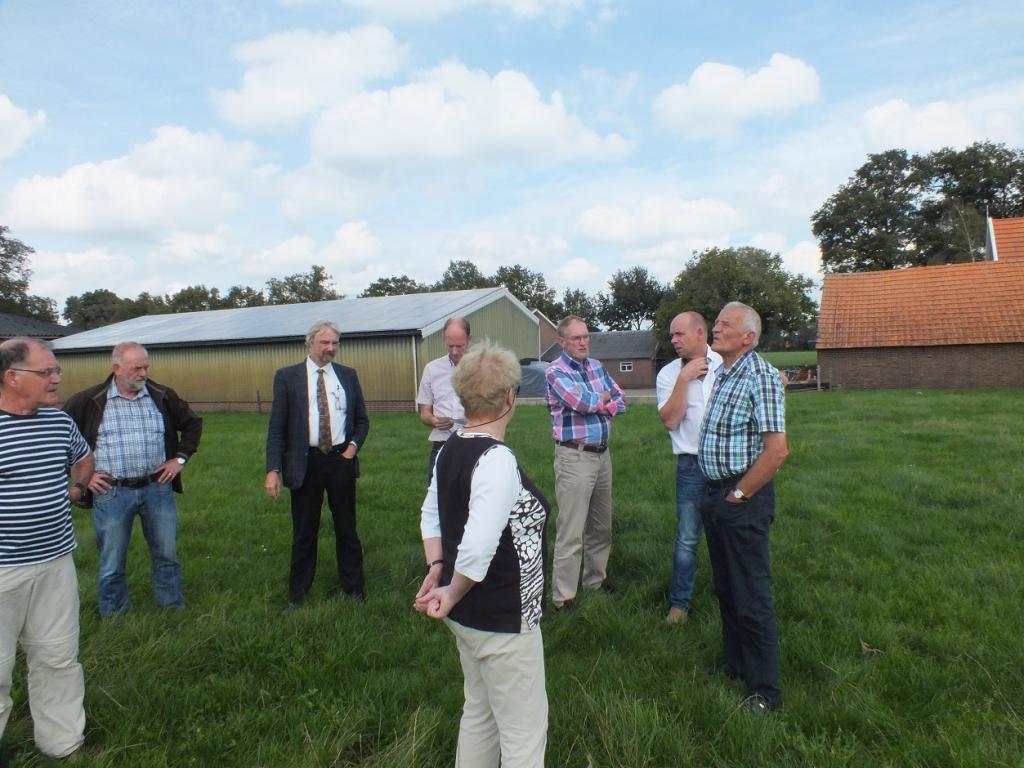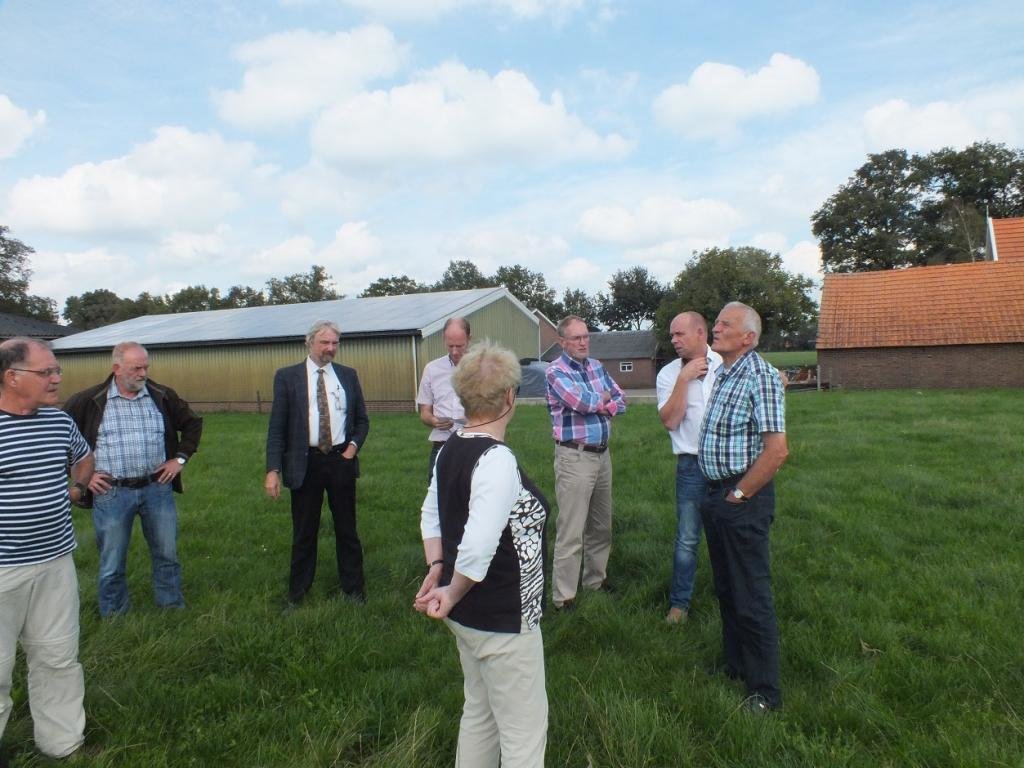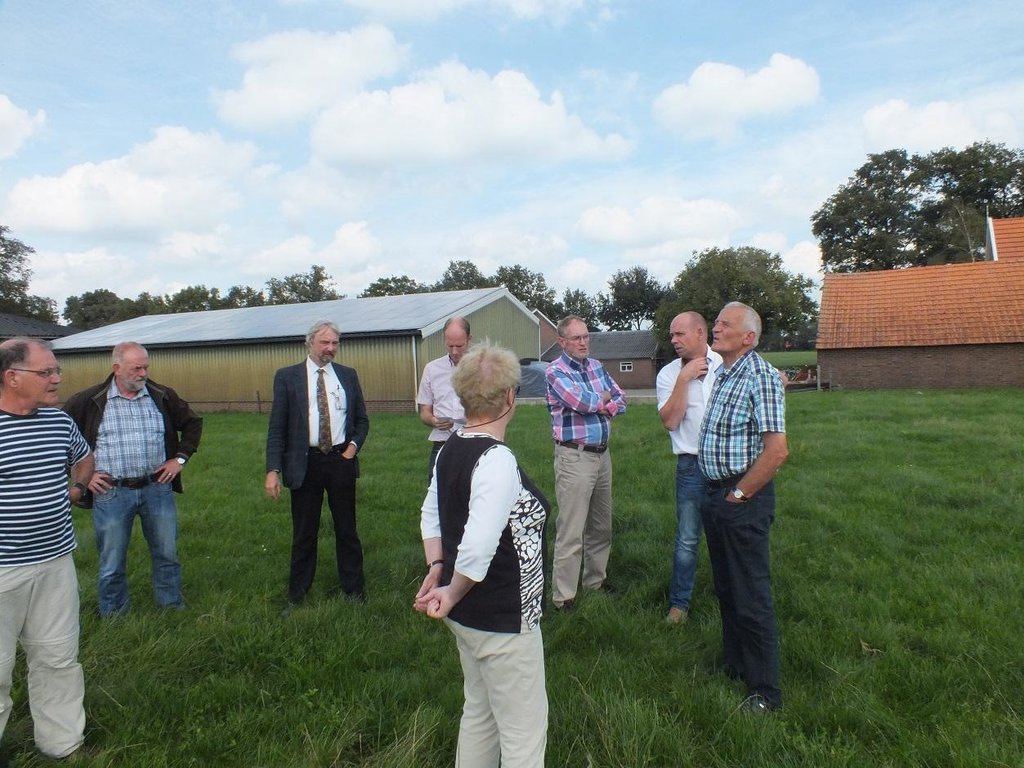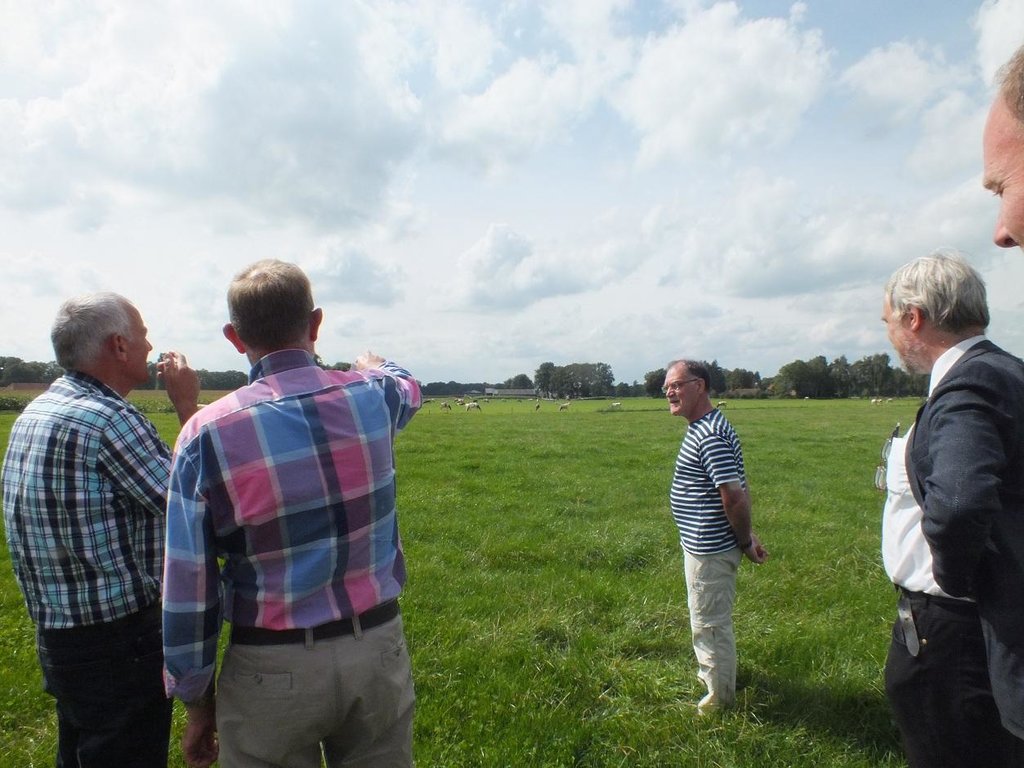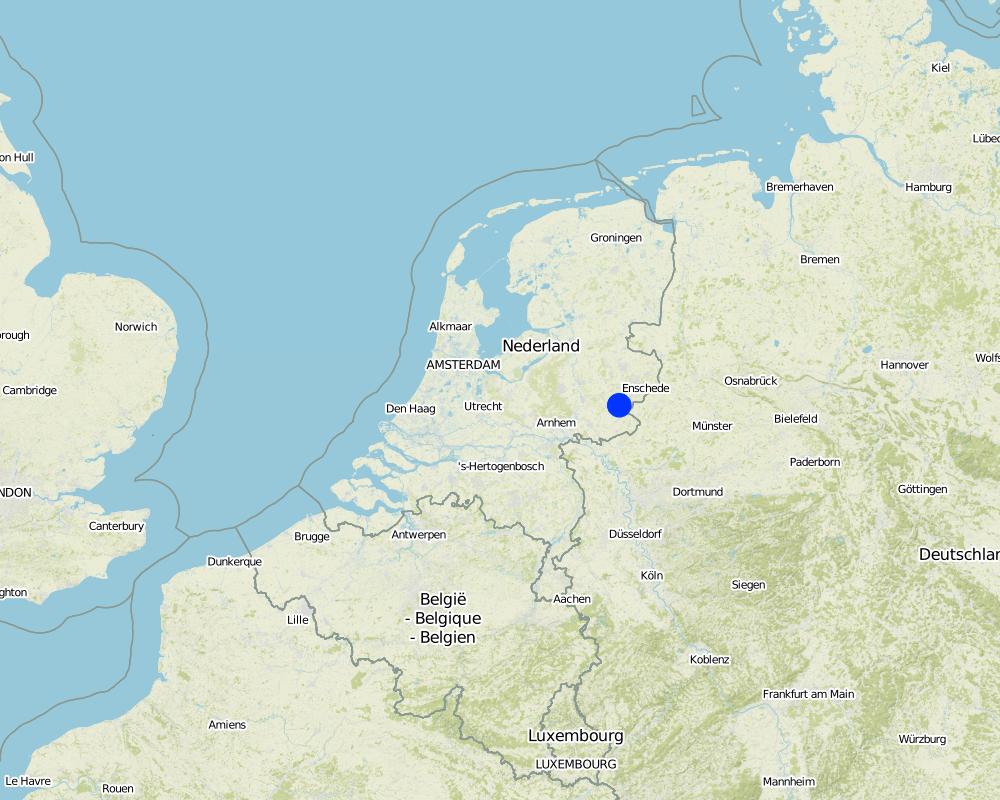Regional process, social innovation [เนเธอร์แลนด์]
- ผู้สร้างสรรค์:
- การอัพเดท:
- ผู้รวบรวม: Simone Verzandvoort
- ผู้เรียบเรียง: –
- ผู้ตรวจสอบ: Fabian Ottiger
Gezond Zand aanpak (Dutch)
approaches_2523 - เนเธอร์แลนด์
ดูส่วนย่อย
ขยายทั้งหมด ย่อทั้งหมด1. ข้อมูลทั่วไป
1.2 รายละเอียดที่ติดต่อได้ของผู้รวบรวมและองค์กรที่เกี่ยวข้องในการประเมินและการจัดเตรียมทำเอกสารของแนวทาง
ผู้เชี่ยวชาญ SLM:
Smit Annemieke
Alterra-Wageningen UR
เนเธอร์แลนด์
ผู้เชี่ยวชาญ SLM:
Rienks Willem
ROM3D
เนเธอร์แลนด์
ชื่อของโครงการซึ่งอำนวยความสะดวกในการทำเอกสารหรือการประเมินแนวทาง (ถ้าเกี่ยวข้อง)
Wageningen Environmental Research (Alterra) - เนเธอร์แลนด์ชื่อของโครงการซึ่งอำนวยความสะดวกในการทำเอกสารหรือการประเมินแนวทาง (ถ้าเกี่ยวข้อง)
Hoe Duurzaam - เนเธอร์แลนด์ชื่อของโครงการซึ่งอำนวยความสะดวกในการทำเอกสารหรือการประเมินแนวทาง (ถ้าเกี่ยวข้อง)
Provincie Gelderland - เนเธอร์แลนด์ชื่อของโครงการซึ่งอำนวยความสะดวกในการทำเอกสารหรือการประเมินแนวทาง (ถ้าเกี่ยวข้อง)
ROM3D - เนเธอร์แลนด์ชื่อของโครงการซึ่งอำนวยความสะดวกในการทำเอกสารหรือการประเมินแนวทาง (ถ้าเกี่ยวข้อง)
Ministerie van Economische Zaken - เนเธอร์แลนด์1.3 เงื่อนไขที่เกี่ยวข้องกับการใช้ข้อมูลที่ได้บันทึกไว้ผ่านทาง WOCAT
วันที่เก็บรวบรวมข้อมูล (ภาคสนาม):
18/09/2014
ผู้รวบรวมและวิทยากรหลักยอมรับเงื่อนไขเกี่ยวกับการใช้ข้อมูลที่ถูกบันทึกผ่านทาง WOCAT:
ใช่
1.4 การอ้างอิงถึงแบบสอบถามเรื่องเทคโนโลยี SLM
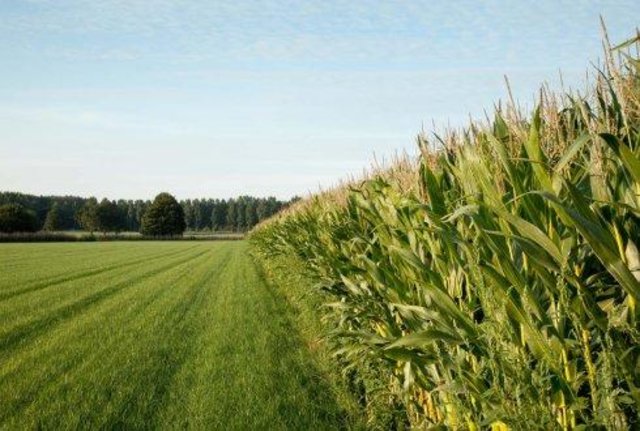
Postpone grassland renewal [เนเธอร์แลนด์]
Postponing the timing of ploughing a grassland field by one or two years to reduce nutrient losses and organic matter decomposition.
- ผู้รวบรวม: Jason Stuka
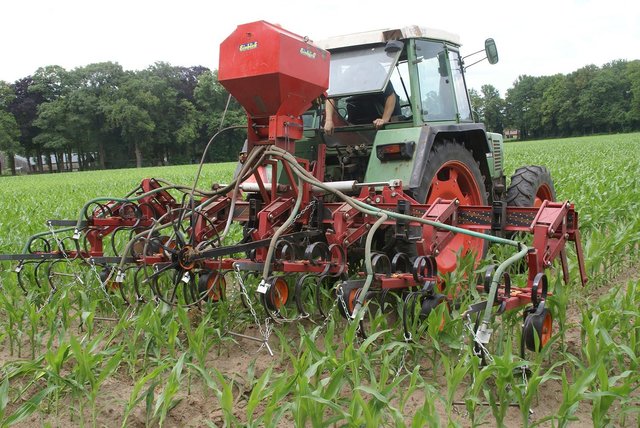
Intercropping of grass and corn to increase soil … [เนเธอร์แลนด์]
Grass intercropping on corn fields
- ผู้รวบรวม: Jason Stuka
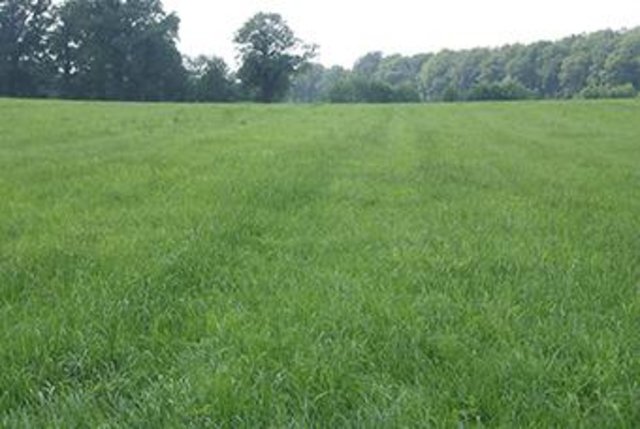
Humic acid application [เนเธอร์แลนด์]
Humic acid application is a technology that allows the farmer to supply organic matter to the soil, without supplying additional nitrogen and phosphorus.
- ผู้รวบรวม: Jason Stuka
2. คำอธิบายของแนวทาง SLM
2.1 การอธิบายแบบสั้น ๆ ของแนวทาง
Social innovation for sustained soil organic matter, clean drinking water and sustainable crop production
2.2 การอธิบายอย่างละเอียดของแนวทาง
การอธิบายอย่างละเอียดของแนวทาง:
Aims / objectives: A group of farmers cooperates with the drinking water company and aims for a more healthy soil. The sandy soil is low in organic matter. They expect that increasing the soil organic matter content will retain more nitrates in the soil, leading to a reduction in nitrate leaching and a higher nutrient availability for the crops.
Dairy farms grow grass and corn. Some farmers also produce potatoes and cereals.
Most farms deal with suboptimal moisture conditions. Increasing the soil organic matter content and improving the soil structure is expected to be a key factor in improving soil moisture content, both in dry and wet periods.
For most farmers soil biodiversity is terra incognita. During the project they will learn about the advantages of good soil fauna and how it can add to better crops.
The case study will explore management options to increase and maintain organic matter content in soil via different rotations, specific varieties of grasses and corn, cover crops and additions of organic amendments and fertilizers. Although the case study is about soil management and technology to improve soil quality, social innovation is a key objective: combining knowledge and experience of a group of neighbours and farmers within a small region and developing solutions and opportunities for the whole area.
Methods: lectures, site visits, group sessions with models (computer sessions), kitchen table interviews (interactive advice), providing relevant literature
Stages of implementation: fund raising - building support - knowledge transfer - pilots of measures - applied expert advice - launch of the foundation HOE Duurzaam - implementation of new measures - increase of nr of participants - field excursion - closing event of the project 'gezond Zand'
Role of stakeholders: Pioneer farmers : initiating and leading the project, fouding HOE Duurzaam
Other farmers : participating, implementing measures, sharing experience
VITENS Drinking water company: providing money and urgency
ROM3d : project leader, motivating farmers, intermediate between area and government
ALterra, Wageningen UR: providing knowledge
Other important information: An adjustment in the national regulations for manure application was an important driving factor for the development of the approach. Farmers were authorised to apply more manure per ha if they have 75% of their land under grassland. This criterion changed to 80% during the implementation of the approach.
2.3 รูปภาพของแนวทาง
2.5 ประเทศ ภูมิภาค หรือสถานที่ตั้งที่ได้นำแนวทางไปใช้
ประเทศ:
เนเธอร์แลนด์
ภูมิภาค/รัฐ/จังหวัด: :
Netherlands, Gelderland
ข้อมูลเฉพาะเพิ่มเติมของสถานที่ตั้ง:
Municipality of Berkelland
Map
×2.6 วันที่เริ่มต้นและสิ้นสุดของแนวทาง
ระบุปีที่เริ่ม:
2011
การสิ้นสุดลง (ถ้าแนวทางไม่ได้ใช้อีกต่อไป):
2014
2.7 ประเภทของแนวทาง
- เป็นนวัตกรรมท้องถิ่นล่าสุด/ นวัตกรรมใหม่
2.8 เป้าหมายหรือวัตถุประสงค์หลักของแนวทาง
The Approach focused mainly on SLM with other activities (energy, landscape conservation, recreation, drinking water)
The main aims and objectives of the approach were social innovation and social learning with regard to sustainable management of the land in the area. This implied combining knowledge and experience from scientists, neighbours and other farmers. The final goals are to improve soil quality, soil organic matter status and groundwater quality.
The SLM Approach addressed the following problems: Decreasing yields, problems with management (water logging, increased irrigation requirements), changed regulation ('manure derogation') that suppressed agricultural production; drinking water production expected problems with nitrate in the groundwater.
2.9 เงื่อนไขที่เอื้ออำนวยหรือเป็นอุปสรรคต่อการนำเทคโนโลยีภายใต้แนวทางนี้ไปปฏิบัติใช้
การมีไว้ให้หรือการเข้าถึงแหล่งการเงินและบริการ
- เป็นอุปสรรค
The device to separate manure in thick and thin fractions could not have been purchased by an individual farmer.
Treatment through the SLM Approach: The foundation purchased the device.
กรอบแนวทางในการดำเนินการด้านกฎหมาย (การถือครองที่ดิน สิทธิในการใช้ที่ดินและน้ำ)
- เอื้ออำนวย
The existing land ownership, land use rights / water rights greatly helped the approach implementation: Ownership made farmers stakeholder, rented land is treated less carefully; renting farmers are less motivated to change their land mmanagement.
- เป็นอุปสรรค
The exchange of manure between farms in order to comply with manure regulations is not allowed by law.
Treatment through the SLM Approach: The approach searches possibilities to consider the project area as a single enterprise unit for complying with the manure regulation.
ความรู้เกี่ยวกับ SLM การเข้าถึงการสนับสนุนด้านเทคนิค
- เป็นอุปสรรค
Grass undersowing is technically complicated to implement, due to the damage that could be brought to the standing crop.
Treatment through the SLM Approach: Skilled agricultural contractors were hired by the farmers jointly; the concern was releived from the individual farmers.
3. การมีส่วนร่วมและบทบาทของผู้มีส่วนได้ส่วนเสียที่เกี่ยวข้อง
3.1 ผู้มีส่วนได้ส่วนเสียที่เกี่ยวข้องในแนวทางนี้และบทบาท
- ผู้ใช้ที่ดินระดับท้องถิ่นหรือชุมชนระดับท้องถิ่น
land users and the Foundation HOEduurzaam
Land users not member of the Foundation, but interested to learn from the project. Foundation HOEduurzaam; 98% of the land is owned by members of the Foundation. Agricultural enterprises in the area are mainly run by men. Knowledge is exchanged a.o. during hunting activities. Mainly men attended the lectures and interactive sessions. 3 women attended in the three year period.
- ผู้เชี่ยวชาญ SLM หรือที่ปรึกษาการเกษตร
Experts the drinking water company Vitens, the fertiliser companu Triferto, the Louis Bolk research Institute (agronomy) and from Wageningen UR (agronomy, plant production and soil science)
- ภาคเอกชน
Vitens Drinking Water Company
- รัฐบาลระดับท้องถิ่น
Municipality of Berkenwoude
- รัฐบาลแห่งชาติ (ผู้วางแผน ผู้ทำการตัดสินใจ)
Province of Gelderland
From the Water board Vechstromen, Municipality Berkelland, Province of Gelderland. Mayor and counseller of the community Berkelland, Deputy of the Province of Gelderland, Ministry of Economic Affairs
- the foundation HOEDuurzaam
HOEDuurzaam. Drinking water company Vitens, agricultural nature association, cultural landscape heritage association
ถ้ามีผู้มีส่วนได้ส่วนเสียหลายคนที่เกี่ยวข้องให้ระบุหน่วยงานตัวแทน:
The approach was designed jointly by national SLM specialists from the consultancy firm ROM3D and Alterra, the land users and the Foundation HOEduurzaam (representing land users, entrepreneurs and citizens in the area). The application for funding at the Province was made by one of the land users on behalf of the land users.
3.2 การเกี่ยวข้องของผู้ใช้ที่ดินระดับท้องถิ่นหรือชุมชนระดับท้องถิ่นในช่วงต่างๆของแนวทาง
| ความเกี่ยวข้องของผู้ใช้ที่ดินระดับท้องถิ่นหรือชุมชนระดับท้องถิ่น | ระบุผู้ที่มีส่วนเกี่ยวข้องและอธิบายกิจกรรม | |
|---|---|---|
| การริเริ่มหรือการจูงใจ | ระดมกำลังด้วยตนเอง | 8 land users submitted the application for funding to the Province to implement the measures |
| การวางแผน | ปฏิสัมพันธ์ | Due to the interactive nature of the project there was no official planning. There was a sequence of knowledge supplied, testing in pilots, assess outcomes, renewed pilots and implementation of measures proven succesfull. |
| การดำเนินการ | ระดมกำลังด้วยตนเอง | |
| การติดตามตรวจสอบหรือการประเมินผล | ปฏิสัมพันธ์ | |
| Research | จ่ายเงินหรือสนับสนุนจากภายนอก | Lectures from external advisors (Peter Kuikman, Coen ter Berg, Jos Groten (Wageningen UR-PPO), Annemieke Smit (Wageningen UR-Alterra), Zwier van der Vechte (Wageningen UR Livestock Research) and calculation sessions with the HLB tool. |
3.4 การตัดสินใจเลือกใช้เทคโนโลยี SLM
ระบุผู้ที่ทำการตัดสินใจเลือกเทคโนโลยีมากกว่าหนึ่งวิธีไปปฏิบัติใช้:
- ผู้ใช้ที่ดินเป็นผู้ตัดสินใจหลัก โดยการสนับสนุนจากผู้เชี่ยวชาญ SLM
การอธิบาย:
The land users took the final decisions in their selection of SLM technologies and measures. The SLM specialists contributed by giving information and advice.
Decisions on the method of implementing the SLM Technology were made by mainly by land users supported by SLM specialists
4. การสนับสนุนด้านเทคนิค การสร้างขีดความสามารถ และการจัดการด้านความรู้
4.1 การสร้างขีดความสามารถ / การอบรม
ได้มีการจัดอบรมให้แก่ผู้ใช้ที่ดินหรือผู้มีส่วนได้ส่วนเสียคนอื่น ๆ หรือไม่:
ใช่
ให้ระบุว่าใครเป็นผู้ได้รับการอบรม:
- ผู้ใช้ที่ดิน
ถ้าเกี่ยวข้อง ให้ระบุ เพศ อายุ สถานภาพ ชาติพันธุ์ เป็นต้น:
male farmers aged between 30 and 60
รูปแบบการอบรม:
- เกษตรกรกับเกษตรกร
- ใช้พื้นที่ทำการสาธิต
- จัดคอร์ส
รูปแบบการอบรม:
- advisory sessions between land users and SLM advis
หัวข้อที่พูด:
fertilisation, soil fertility, crop management
4.2 การบริการให้คำแนะนำ
ผู้ใช้ที่ดินมีการเข้าถึงการรับบริการให้คำปรึกษาหรือไม่:
ใช่
ระบุว่ามีบริการให้คำปรึกษาหรือไม่:
- ไปเยี่ยมชมสถานที่
การอธิบาย/แสดงความคิดเห็น:
Name of method used for advisory service: 'zitdagen'; advisory sessions between land user and consultant; Key elements: problem analysis: which fields have the largest problems and why? training sessions with the computer tool for selection of measures to improve OM status, meetings for knowledge exchange; There was also a questionnaire to inventory the measures farmers wanted to implement.
Advisory service is quite adequate to ensure the continuation of land conservation activities; The Foundation HOEduurzaam will support the continuation of SLM activities in the area.
4.3 การเสริมความแข็งแกร่งให้กับสถาบัน (การพัฒนาองค์กร)
สถาบันได้รับการจัดตั้งขึ้นมาหรือเสริมความแข็งแกร่งโดยแนวทางนี้หรือไม่:
- ใช่ เล็กน้อย
ระบุระดับของสถาบันที่ได้รับการเสริมความแข็งแกร่งหรือจัดตั้งขึ้นมา:
- ท้องถิ่น
ระบุประเภทของการให้ความช่วยเหลือสนับสนุน:
- ด้านการเงิน
- การสร้างขีดความสามารถ / การอบรม
- marketing
ให้รายละเอียดเพิ่มเติม :
Foundation HOEduurzaam has small financial revenues from their activities. Campsite Veldzicht rented their accommodation several times for venues of the land users and stakeholders, and will benefit from publicity around the approach to attract more visitors.
4.4 การติดตามตรวจสอบและประเมินผล
การติดตามตรวจสอบและประเมินผลเป็นส่วนหนึ่งของแนวทางหรือไม่:
ใช่
ความคิดเห็น:
bio-physical aspects were ad hoc monitored by project staff through observations; indicators: pictures of development of grass undersowing and crops
bio-physical aspects were ad hoc monitored by land users, other through measurements; indicators: land users should measure OM every 4 years to get subsidies; constituents of the groundwater used to produce drinking water
There were no changes in the Approach as a result of monitoring and evaluation: The approached worked well, so there were no changes until now.
There were few changes in the Technology as a result of monitoring and evaluation: Several technologies were abandoned or could not be implemented: substituting crops in rotations (less potatoes, early germinating maize varieties), use of roadside rsidues as compost (due to legal constraints)
Humic acid was implemented at more fields after the first optimistic results. The early harvest of corn was not implemented, but sowing grasss underneath the corn was developed during the project.
4.5 การวิจัย
การวิจัยเป็นส่วนหนึ่งของแนวทางหรือไม่:
ใช่
ระบุหัวข้อเรื่อง:
- เศรษฐศาสตร์หรือการตลาด
- เทคโนโลยี
ให้ข้อมูลเพิ่มเติมและให้ระบุผู้ทำการวิจัย:
economics/marketing: cost-benefit analysis still to be performed - ROM3D and Alterra and Foundation HOEduurzaam
technology: continued search for new methods and measures; mapping the status of soil organic matter and soil organic matter balance calculations with a tool - Alterra, ROM3 and Foundation HOEduurzaam
Research was carried out both on station and on-farm
5. การสนับสนุนด้านการเงินและวัสดุอุปกรณ์
5.1 ระบุงบประมาณประจำปีสำหรับแนวทาง SLM นี้
ถ้าหากว่างบประมาณประจำปีไม่เป็นที่ทราบแน่นอน ให้ระบุช่วงลงไป:
- 10,000-100,000
แสดงความคิดเห็น (แหล่งของการระดมทุน ผู้บริจาคคนสำคัญ):
Approach costs were met by the following donors: international (European Fund for Rural Development and the EU FP7 RECARE project): 5.0%; government (Ministry of Economic Affairs ): 40.0%; private sector (Vitens drinking water company): 10.0%; local government (district, county, municipality, village etc) (Province of Gelderland (100-350 €/ha) - subsidy regulation for sustainable soil management): 35.0%; local community / land user(s) (labour, time investment, seeds, materials): 5.0%; other (own contributions research and consultancy firms (Alterra, ROM3D)): 5.0%
5.2 การสนับสนุนด้านการเงิน / วัสดุอุปกรณ์ให้แก่ผู้ใช้ที่ดิน
ผู้ใช้ที่ดินได้รับการสนับสนุนด้านการเงิน / วัสดุอุปกรณ์ไปปฏิบัติใช้เทคโนโลยีหรือไม่:
ใช่
5.3 เงินสนับสนุนสำหรับปัจจัยนำเข้า (รวมถึงแรงงาน)
- อุปกรณ์
| ระบุปัจจัยนำเข้าที่ได้รับการสนับสนุน | เห็นด้วยระดับไหน | ระบุเงินสนับสนุน |
|---|---|---|
| เครื่องจักร | ได้รับการช่วยเหลือทางการเงินบางส่วน | Manure separator |
- การเกษตร
| ระบุปัจจัยนำเข้าที่ได้รับการสนับสนุน | เห็นด้วยระดับไหน | ระบุเงินสนับสนุน |
|---|---|---|
| เมล็ด | ได้รับการช่วยเหลือทางการเงินบางส่วน | |
| Human acids | ได้รับการช่วยเหลือทางการเงินบางส่วน | |
ความคิดเห็น:
payments were meant to cover potential costs of reduced crop yield and the agricultural contractor (loonwerker)
5.4 เครดิต
มีการจัดหาเครดิตมาให้ภายใต้แนวทาง SLM หรือไม่:
ไม่ใช่
6. การวิเคราะห์ผลกระทบและการสรุป
6.1 ผลกระทบของแนวทาง
ช่วยให้ผู้ใช้ที่ดินนำเอาเทคโนโลยี SLMไปใช้และบำรุงรักษาสภาพไว้ได้หรือไม่:
- ไม่ใช่
- ใช่ เล็กน้อย
- ใช่ ปานกลาง
- ใช่ อย่างมาก
Farmers are more concerned about soil and organic matter, they understand that they have options to improve and make choices in implementation of measures. Some measures need coordination at the aera level (e.g. the use of goat manure and roadside residues), those were not implemented yet, but small scale mearsures are becoming more common.
ทำให้กลุ่มด้อยโอกาสมีอำนาจทางสังคมและเศรษฐกิจหรือไม่:
- ไม่ใช่
- ใช่ เล็กน้อย
- ใช่ ปานกลาง
- ใช่ อย่างมาก
no socially and economically disadvantaged groups in this area
ปรับปรุงประเด็นของการถือครองที่ดินหรือสิทธิในการใช้ ซึ่งขัดขวางการนำเทคโนโลยีไปใช้ให้ดีขึ้น:
- ไม่ใช่
- ใช่ เล็กน้อย
- ใช่ ปานกลาง
- ใช่ อย่างมาก
Ownership of the land made it possible for the farmers to decide what management was implemented. Hindering: when fields were rented by farmers outside the area/project, poor management of the soil decreased the soil organic matter content.
Did other land users / projects adopt the Approach?
- ไม่ใช่
- ใช่ เล็กน้อย
- ใช่ ปานกลาง
- ใช่ อย่างมาก
Did the Approach lead to improved livelihoods / human well-being?
- ไม่ใช่
- ใช่ เล็กน้อย
- ใช่ ปานกลาง
- ใช่ อย่างมาก
Farmers learned about how others are working and they met more regularly in an informal setting.
Did the Approach help to alleviate poverty?
- ไม่ใช่
- ใช่ เล็กน้อย
- ใช่ ปานกลาง
- ใช่ อย่างมาก
Poverty does not occur in the area.
6.2 แรงจูงใจหลักของผู้ใช้ที่ดินเพื่อที่จะนำ SLM ไปปฏิบัติใช้
- การผลิตที่เพิ่มขึ้น
The dairy farmer's income is under pressure due to the low milk price.
- กำไร (ความสามารถ) อัตราส่วนค่าใช้จ่ายต่อผลประโยชน์ที่เพิ่มขึ้น
Farmers realise that in the long term, declining soil organic matter will reduce production.
- กฎและระเบียบ (ค่าปรับ) หรือการบังคับใช้
Stricter manure regulation under the CAP forces farmers to manage organic matter efficiently.
- การเข้าร่วมสมทบในขบวนการ โครงการ กลุ่ม เครือข่าย
Farmers are interested to learn improvements for farm management from other farmers.
- จิตสำนึกด้านสิ่งแวดล้อม
Farmers care for their land and animals. Also for good quality groundwater.
6.3 ความยั่งยืนของกิจกรรมของแนวทาง
ผู้ใช้ที่ดินสามารถทำให้สิ่งต่างๆ ที่ได้ปฏิบัติใช้โดยแนวทางนี้ยั่งยืนได้หรือไม่ (โดยไม่มีการสนับสนุนจากภายนอก):
- ใช่
ถ้าตอบว่าใช่ ให้อธิบายว่าอย่างไร :
The Foundation HOEduurzaam will continue to act in the area. For the next 10 years measures will be part
of the subsidy grant.
6.4 จุดแข็งและข้อได้เปรียบของแนวทาง
| จุดแข็ง / ข้อได้เปรียบของแนวทางในทัศนคติของผู้ใช้ที่ดิน |
|---|
| Farmers are positive about the information provision on the measures in the informatoin sessions, by their mutual exchange of information, and through the direct contact with experts. They expect the measures to increase the soil organic matter and yields, also through an improved bearing capacity of the soil. (How to sustain/ enhance this strength: Continued exchange of information on measures to increase SOM between the farmers themselves, subsidy to finance the measures (either through the regional government or the dairy company).) |
| จุดแข็ง / ข้อได้เปรียบของแนวทางในทัศนคติของผู้รวบรวมหรือวิทยากรหลัก |
|---|
|
1. social innovation by working together and learning from each other 2. HOEduurzaam (foundation) represents 98% of the land owners and land users in the area, and is an important stakeholder for the local /regional goverment 3. all training was specifically designed for the group 4. HOEduurzaam is also active in the Energie-marke, a local renewable energy cooperative (How to sustain/ enhance this strength: continuing the approach, Foundation HOEduurzaam remaining active, follow-up projects to monitor effects of measures to stimulate farmers to continue to implement the measures. ) |
6.5 จุดอ่อน / ข้อเสียเปรียบของแนวทางและวิธีในการแก้ไข
| จุดอ่อน / ข้อเสียเปรียบในทัศนคติของผู้ใช้ที่ดิน | สามารถแก้ไขปัญหาได้อย่างไร |
|---|---|
| No disadvantages to the approach were mentioned by the land users. | not applicable |
| จุดอ่อน / ข้อเสียเปรียบในทัศนคติของผู้รวบรวมหรือวิทยากรหลัก | สามารถแก้ไขปัญหาได้อย่างไร |
|---|---|
|
1. support of the measures by consultants was only 2 years, whereas the effects on SOM are only perceptable after 10 years 2. Foundation HOEduurzaam does not have a soil expert |
Bring attention to production and water use. |
7. การอ้างอิงและการเชื่อมต่อ
7.1 วิธีการหรือแหล่งข้อมูล
- ไปเยี่ยมชมภาคสนาม การสำรวจพื้นที่ภาคสนาม
- การสัมภาษณ์กับผู้ใช้ที่ดิน
7.2 การอ้างอิงถึงสิ่งตีพิมพ์
ชื่อเรื่อง ผู้เขียน ปี ISBN:
website of the Foundation HOEduurzaamW.A. Rienks en H. Leever, 2014. Gezond Zand – organische stof als sleutel voor een vruchtbare bodem en schoon water.
ช่องทางในการสืบค้น และราคา:
http://www.hoeduurzaam.nl http://www.hoeduurzaam.nl/images/gallery/nieuws/Brochure/BrochureHoeduurzaam%20Definitief.pdf
ชื่อเรื่อง ผู้เขียน ปี ISBN:
W.A. Rienks en H. Leever, 2014. Gezond Zand – organische stof als sleutel voor een vruchtbare bodem en schoon water.
ช่องทางในการสืบค้น และราคา:
http://www.hoeduurzaam.nl/images/gallery/nieuws/Brochure/BrochureHoeduurzaam%20Definitief.pdf
ลิงก์และโมดูล
ขยายทั้งหมด ย่อทั้งหมดลิงก์

Postpone grassland renewal [เนเธอร์แลนด์]
Postponing the timing of ploughing a grassland field by one or two years to reduce nutrient losses and organic matter decomposition.
- ผู้รวบรวม: Jason Stuka

Intercropping of grass and corn to increase soil … [เนเธอร์แลนด์]
Grass intercropping on corn fields
- ผู้รวบรวม: Jason Stuka

Humic acid application [เนเธอร์แลนด์]
Humic acid application is a technology that allows the farmer to supply organic matter to the soil, without supplying additional nitrogen and phosphorus.
- ผู้รวบรวม: Jason Stuka
โมดูล
ไม่มีโมดูล


